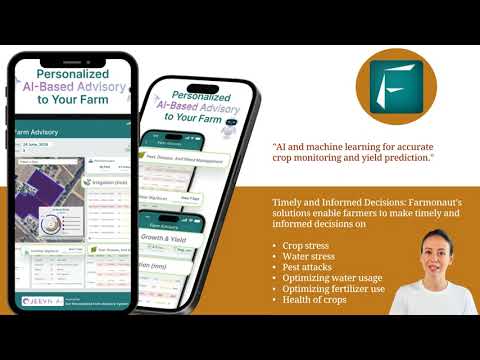Maximize Corn and Soybean Yields: Farmonaut’s 2024 Precision Agriculture Guide for Iowa and Nebraska Farmers
“Iowa and Nebraska farmers can potentially increase corn and soybean yields by up to 20% using precision agriculture techniques.”
As we delve into the heart of the 2024 growing season, corn and soybean management takes center stage for farmers across Iowa and Nebraska. At Farmonaut, we’re committed to empowering agriculturists with cutting-edge precision agriculture technology to navigate the challenges and opportunities that lie ahead. In this comprehensive guide, we’ll explore the latest trends, strategies, and insights to help you maximize your yields and optimize your farming operations.
The Current State of Corn and Soybean Crops in the Midwest
The 2024 season has presented a unique set of challenges and opportunities for corn and soybean farmers in Iowa and Nebraska. Let’s break down the current situation:
- Early planting strategies have been crucial this year, with many farmers taking advantage of favorable weather windows in April and May.
- Crop yield prediction models are showing promise, but weather volatility remains a significant factor.
- Precision agriculture technology adoption is on the rise, with more farmers leveraging data-driven insights for decision-making.
To get a clearer picture of the situation, let’s take a look at our comparative crop performance analysis:
| Crop Type | State | Average Yield Estimate (bushels/acre) | Primary Weather Challenges | Notable Pest/Disease Issues | Precision Agriculture Impact |
|---|---|---|---|---|---|
| Corn | Iowa | 185 | Excessive rainfall in June | Black cutworm, tar spot | 10% yield increase through optimized irrigation |
| Soybeans | Iowa | 55 | High temperatures in July | Soybean aphids, sudden death syndrome | 15% reduction in pesticide use via targeted application |
| Corn | Nebraska | 180 | Drought conditions in western regions | Western bean cutworm, southern rust | 12% water savings through precision irrigation |
| Soybeans | Nebraska | 52 | Hail damage in central areas | Japanese beetles, white mold | 8% yield increase with variable rate seeding |
As we can see, both corn and soybean crops face unique challenges across Iowa and Nebraska. However, with the right approach and tools, there’s significant potential for yield optimization.
Weather’s Impact on Agriculture: A Critical Factor
Weather conditions have been a rollercoaster ride for Midwest farmers this season. Let’s break down the key weather-related factors affecting corn and soybean crops:
- Excessive Rainfall: Parts of Iowa experienced above-average precipitation in June, leading to concerns about root development and nutrient leaching in corn fields.
- High Temperatures: July brought heat waves across both states, potentially impacting pollination in corn and pod development in soybeans.
- Drought Conditions: Western Nebraska continues to grapple with dry conditions, putting stress on both corn and soybean crops.
At Farmonaut, we understand the critical role weather plays in agriculture. Our advanced satellite-based monitoring system provides real-time insights into weather patterns and their potential impact on your crops. By leveraging this data, farmers can make informed decisions about irrigation, pest management, and harvest timing.

Precision Agriculture Technology: Your Key to Success
In the face of these challenges, precision agriculture technology emerges as a game-changer for corn and soybean management. Here’s how Farmonaut’s cutting-edge solutions can help you stay ahead of the curve:
- Satellite-Based Crop Health Monitoring: Our advanced remote sensing technology provides detailed insights into crop health, allowing you to identify issues before they become visible to the naked eye.
- AI-Powered Yield Prediction: Leverage machine learning algorithms to forecast potential yields and make data-driven decisions throughout the growing season.
- Precision Irrigation Management: Optimize water usage by identifying areas of your field that need more or less irrigation, saving resources and improving crop health.
- Variable Rate Application: Apply fertilizers and pesticides with pinpoint accuracy, reducing waste and maximizing effectiveness.
To see how our technology works in action, check out this informative video:
Ready to revolutionize your farming operations? Access Farmonaut’s powerful tools through our web app, mobile apps, or API:
For developers looking to integrate our powerful satellite and weather data into their own systems, check out our API and API Developer Docs.
Crop Disease Monitoring: Staying Vigilant
“Excessive rainfall and high temperatures in the Midwest can reduce crop yields by up to 30% in severe cases.”
The 2024 season has seen an uptick in certain crop diseases, partly due to weather conditions. Here’s what Iowa and Nebraska farmers need to watch out for:
Corn Diseases
- Tar Spot: This fungal disease has been spreading in Iowa, particularly in fields with a history of infection and high moisture levels.
- Southern Rust: With warmer temperatures, southern rust has made an early appearance in Nebraska corn fields.
- Northern Corn Leaf Blight: Moderate levels have been reported in both states, especially in susceptible hybrids.
Soybean Diseases
- Sudden Death Syndrome (SDS): Early-planted soybeans in Iowa are showing signs of SDS, exacerbated by wet conditions.
- White Mold: High humidity in parts of Nebraska has created favorable conditions for white mold development.
- Frogeye Leaf Spot: This disease is becoming more prevalent in both states, particularly in fields with a history of infection.
Farmonaut’s satellite-based crop health monitoring system can help you detect disease outbreaks early, allowing for timely intervention and minimizing yield losses. Our AI-powered analytics can identify subtle changes in crop health that may indicate the onset of disease, giving you a crucial head start in disease management.
Grain Filling Period Optimization: Maximizing Yield Potential
As we move into the critical grain filling period for both corn and soybeans, optimizing conditions during this time can significantly impact your final yields. Here are some key strategies to consider:
- Moisture Management: Ensure adequate soil moisture during grain fill, especially for corn. Our precision irrigation tools can help you maintain optimal moisture levels without overwatering.
- Nutrient Availability: Late-season nitrogen applications for corn and foliar fertilizers for soybeans can support grain development. Use our variable rate application technology to apply nutrients precisely where they’re needed most.
- Pest and Disease Control: Continue monitoring for late-season pests and diseases that can impact grain quality. Our crop health monitoring system can alert you to potential issues before they become severe.
- Stress Mitigation: Minimize plant stress from heat or drought, particularly in soybeans. Our weather forecasting and crop stress detection features can help you stay ahead of potential problems.
By focusing on these factors during the grain filling period, you can maximize the potential of your crops and set the stage for a successful harvest.

Agricultural Pest Control: Integrated Pest Management Strategies
Effective pest management is crucial for protecting your corn and soybean yields. Here’s an overview of the major pests to watch for in Iowa and Nebraska, along with integrated pest management (IPM) strategies:
Corn Pests
- Western Corn Rootworm: Use crop rotation and consider Bt corn varieties in high-pressure areas.
- European Corn Borer: Monitor for egg masses and consider Bt corn or targeted insecticide applications.
- Black Cutworm: Scout early and be prepared with rescue treatments if necessary.
Soybean Pests
- Soybean Aphids: Utilize economic thresholds and preserve natural enemies before applying insecticides.
- Japanese Beetles: Scout regularly and consider treatment if defoliation exceeds 30% before bloom or 20% between bloom and pod fill.
- Spider Mites: Monitor closely during hot, dry conditions and treat promptly if populations build up.
Farmonaut’s precision agriculture technology can support your IPM efforts by providing early detection of pest hotspots and enabling targeted treatments. Our satellite imagery and AI analytics can identify areas of crop stress that may indicate pest activity, allowing for precise and timely interventions.
Early Planting Strategies: Getting a Head Start
Early planting can offer significant yield advantages for both corn and soybeans, but it’s not without risks. Here’s how to make the most of early planting opportunities:
- Monitor Soil Conditions: Use Farmonaut’s soil moisture monitoring tools to ensure fields are dry enough for planting without risking compaction.
- Choose Appropriate Hybrids/Varieties: Select corn hybrids and soybean varieties that are well-suited for early planting in your specific region.
- Manage Residue: Ensure proper residue management to allow for quicker soil warming and drying in the spring.
- Be Prepared for Replanting: Have a replanting strategy in place in case of poor emergence or late frost damage.
Our precision agriculture tools can help you make data-driven decisions about planting timing, taking into account factors like soil temperature, moisture levels, and weather forecasts.
Herbicide Injury Prevention: Protecting Your Investment
Herbicide injury can significantly impact crop yields if not properly managed. Here are some key strategies to prevent herbicide damage in your corn and soybean fields:
- Proper Application Timing: Apply herbicides at the correct crop growth stage and under appropriate weather conditions.
- Accurate Sprayer Calibration: Ensure your sprayer is properly calibrated to apply the correct amount of herbicide.
- Avoid Drift: Use drift reduction nozzles and avoid spraying in windy conditions to prevent off-target movement.
- Tank Mix Compatibility: Be cautious with tank mixes and always check for compatibility before combining products.
- Follow Label Instructions: Adhere strictly to herbicide label instructions regarding rates, timing, and crop safety.
Farmonaut’s precision agriculture technology can assist in preventing herbicide injury by providing accurate field mapping and variable rate application capabilities. This ensures that herbicides are applied only where needed and at the correct rates, minimizing the risk of crop damage while maximizing weed control efficacy.
Agronomy Data Analysis: Turning Information into Action
In today’s data-driven agricultural landscape, the ability to analyze and interpret agronomic data is crucial for making informed decisions. Farmonaut’s advanced analytics platform offers powerful tools for agronomy data analysis, including:
- Yield Data Interpretation: Analyze historical and current yield data to identify trends and optimize future crop management strategies.
- Soil Sampling Integration: Incorporate soil test results into our platform for precise nutrient management recommendations.
- Weather Data Correlation: Understand the impact of weather patterns on your crop performance and adjust management practices accordingly.
- Satellite Imagery Analysis: Utilize multispectral satellite images to assess crop health, detect stress, and identify management zones within your fields.
By leveraging these analytical tools, you can gain deeper insights into your farm’s performance and make data-driven decisions that lead to improved yields and profitability.
Looking Ahead: 2024 Crop Outlook for Iowa and Nebraska
As we progress through the 2024 growing season, here’s what farmers in Iowa and Nebraska can expect:
Iowa Outlook
- Corn: Despite early-season challenges, corn yield potential remains strong, with an estimated state average of 185 bushels per acre.
- Soybeans: Soybean crops are showing promise, with potential yields around 55 bushels per acre, contingent on favorable late-season conditions.
Nebraska Outlook
- Corn: Yield estimates vary across the state due to diverse growing conditions, with a projected average of 180 bushels per acre.
- Soybeans: Soybean yields are expected to average around 52 bushels per acre, with higher potential in areas that received timely rainfall.
Remember, these are statewide averages, and individual farm yields can vary significantly based on local conditions and management practices. Farmonaut’s precision agriculture tools can help you optimize your specific fields for maximum yield potential.
Embracing Precision Agriculture with Farmonaut
As we’ve explored throughout this guide, precision agriculture technology is revolutionizing corn and soybean management. Farmonaut is at the forefront of this transformation, offering cutting-edge solutions that empower farmers to make data-driven decisions and optimize their operations.
By leveraging our satellite-based crop monitoring, AI-powered analytics, and precision application tools, you can:
- Increase yields through targeted management practices
- Reduce input costs by optimizing resource use
- Minimize environmental impact through precision application of inputs
- Stay ahead of pest and disease pressures with early detection
- Make informed decisions based on real-time data and insights
Ready to take your farming operation to the next level? Explore our subscription options and find the perfect plan for your needs:
Frequently Asked Questions
Q: How can Farmonaut’s technology help me improve my corn and soybean yields?
A: Farmonaut’s precision agriculture tools provide real-time crop health monitoring, weather insights, and data-driven recommendations. This allows you to optimize irrigation, fertilization, and pest management, leading to potentially higher yields and reduced input costs.
Q: Is Farmonaut’s technology suitable for small family farms as well as large operations?
A: Yes, Farmonaut’s solutions are scalable and can benefit farms of all sizes. We offer different subscription tiers to accommodate various farm sizes and needs.
Q: How accurate is Farmonaut’s satellite-based crop monitoring?
A: Our satellite imagery provides high-resolution data with frequent updates. While exact accuracy can vary depending on conditions, our technology consistently delivers valuable insights for informed decision-making.
Q: Can Farmonaut’s tools help me comply with environmental regulations?
A: Yes, our precision agriculture technology can help you optimize input use and reduce environmental impact, supporting compliance with many agricultural regulations.
Q: How often is the satellite data updated?
A: The frequency of updates depends on your subscription tier, but we typically provide new imagery every 3-5 days, weather permitting.
Conclusion: Embracing the Future of Farming
As we look towards the future of corn and soybean farming in Iowa, Nebraska, and beyond, it’s clear that precision agriculture will play an increasingly vital role. By embracing these technologies and strategies, you can position your farm for success in the face of evolving challenges and opportunities.
Farmonaut is committed to supporting your journey towards more efficient, productive, and sustainable farming practices. Our advanced satellite-based monitoring, AI-powered analytics, and user-friendly tools are designed to give you the insights you need to make confident decisions and maximize your yields.
Remember, the key to success lies in staying informed, adapting to changing conditions, and leveraging the power of data-driven agriculture. With Farmonaut as your partner, you’re well-equipped to navigate the complexities of modern farming and achieve your goals for the 2024 season and beyond.
Ready to take the next step? Explore our platform, sign up for a subscription, or reach out to our team for personalized support. Together, we can cultivate a more prosperous and sustainable future for agriculture.
Let’s work together to maximize your corn and soybean yields with the power of precision agriculture. The future of farming is here – are you ready to embrace it?





